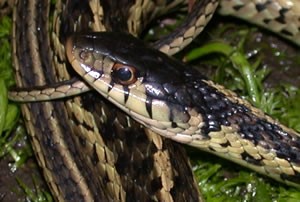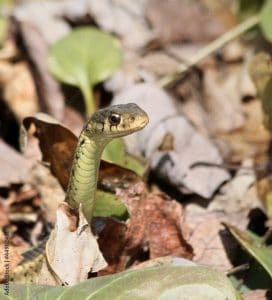Some snakes are good for the garden. This article focuses on a common one, the garter snake, so you can learn to identify and make peace with it. It’s best to internalize this information because a snake encounter in the garden is always a surprise. You’re focused on weeding or checking your plants, maybe you pull some vegetation back and there it is – a curled up snake or the back end of a snake slithering away. Admit it, the first impulse is a sharp intake of breath with a dash of fear. At least a dash. Is this snake dangerous to me or a threat to my pets? Few wonder “Is this snake good for my garden”?
Too often, people lump all snakes into a single category – venomous. And they act accordingly, sometimes killing the snake without ever trying to identify the species. Harmless snakes get crushed, stabbed, smashed and poisoned to death because people don’t understand some basic snake facts.
Poison vs Venom
The difference between poison and venom is that poison is ingested and venom is injected. That’s why snakes are regarded as venomous or non-venomous. “Non-venomous” means their bite will not inject poison into your body. Most snakes are non-venomous.
Basic eastern garter snake facts
The eastern garter snake is a non-venomous snake that’s found in gardens along the eastern United States and in parts of Canada. The eastern garter snake is also called a common garter snake, which is what many people refer to as a “garden snake”. Take a good look at the black markings on the lower part of the snake’s face, in this photo. Memorize those markings. They are an identifying factor and a way to differentiate a garter snake from a ribbon snake. Those markings are absent on a ribbon snake, which otherwise looks quite like a garter snake. If you live near water, you may come across ribbon snakes. Ribbon snakes are also non-venomous, so no worries.
garter snake, which is what many people refer to as a “garden snake”. Take a good look at the black markings on the lower part of the snake’s face, in this photo. Memorize those markings. They are an identifying factor and a way to differentiate a garter snake from a ribbon snake. Those markings are absent on a ribbon snake, which otherwise looks quite like a garter snake. If you live near water, you may come across ribbon snakes. Ribbon snakes are also non-venomous, so no worries.
PROFILE:
Eastern Garter Snake/Common Garter Snake (Thamnophis sirtalis)
• 18-26 inches long avg., can be longer
• Belly is white or light yellow
• Found throughout the US, common in the southeastern states
• Prefers to be near water but will live almost anywhere
• Can be found in debris piles, vegetation, rocks, logs
• Eats slugs, rodents, worms, and amphibians
• May be active during the day or at night
• They hibernate in winter (but may come out on warm days)
• Protected in Georgia
What to do when you encounter a garter snake in your garden
You’re most likely to encounter a garter snake in spring and summer. Let’s say you’re working in the garden and come upon one. Say hi. Don’t touch it. Don’t poke it. Remember they are shy and not at all aggressive. But, if you try to handle it, it might get defensive and bite you and/or release a super foul odor to disc ourage your presence. If you see it lower its head and lift that tail, hold your breath!
ourage your presence. If you see it lower its head and lift that tail, hold your breath!
If you mistakenly grab one and it bites you – wash the bite area thoroughly. There may be some minor irritation, but that should be all you experience, if that much.
Ok, so far we know –
1. Leave it alone
2. As defense, it may release a big, bad snake fart
3. Their bites can cause minor irritation
4. Wash a bite site thoroughly
How are garter snakes good for my garden?
What garter snakes have going for them is the whole non-venomous thing and the fact that they eat slugs and rodents. If slugs have ever treated your garden like an all-you-can-eat buffet, then you’ll gladly welcome garter snakes to your garden. The mice these snakes eat can carry the Lyme disease bacteria. If those mice aren’t around the Lyme disease-carrying ticks aren’t around either, and that’s a good thing. Snakes are good pest control in the garden.
What if I don’t want garter snakes in my yard or garden?
There are a few things you can do to prevent garter snakes, or snakes in general, from taking residence in your yard or garden:
• Remove piles of debris, leaves, wood or rocks; hay bales; anything stacked that they can hide in

• They use holes other animals have created and abandoned – cover them up!
• Keep your lawn mown. Snakes hide in tall grass.
• Feed your pets indoors. Pet food left out attracts rodents (live snake food).
A more comprehensive list can be found at the Utah State University Extension.
Next time you encounter a garter snake in the garden, I hope you’ll be kind, say “hi” and “thank you”, note where they might be living, and move on to another part of your garden.
Whatever you do, please refrain from harming or killing these innocent snakes.
